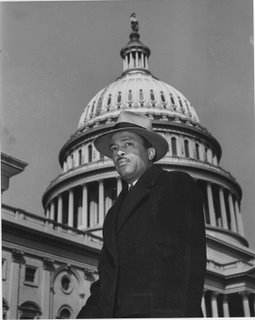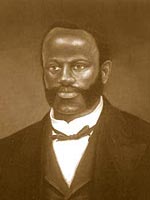
"Those who have no record of what their forebears have accomplished lose the inspiration which comes from the teaching of biography and history."
These are the words of Dr. Carter Godwin Woodson, distinguished Black author, editor, publisher, and historian (December 1875 - April 1950). Carter G. Woodson believed that Blacks should know their past in order to participate intelligently in the affairs in our country. He strongly believed that Black history - which others have tried so diligently to erase - is a firm foundation for young Black Americans to build on in order to become productive citizens of our society.
Known as the "Father of Black History," Carter G. Woodson holds an outstanding position in early 20th century American history. Woodson authored numerous scholarly books on the positive contributions of Blacks to the development of America. He also published many magazine articles analyzing the contributions and role of Black Americans. He reached out to schools and the general public through the establishment of several key organizations and founded Negro History Week (precursor to Black History Month). His message was that Blacks should be proud of their heritage and that other Americans should also understand it.
Carter G. Woodson was born in New Canton, Buckingham County, Virginia, to former slaves Anne Eliza (Riddle) and James Henry Woodson. Although his parents could neither read nor write, Carter G. Woodson credits his father for influencing the course of his life. His father, he later wrote, insisted that "learning to accept insult, to compromise on principle, to mislead your fellow man, or to betray your people, is to lose your soul."
His father supported the family on his earnings as a carpenter. As one of a large and poor family, young Carter G. Woodson was brought up without the "ordinary comforts of life." He was not able to attend school during much of its five-month term because helping on the farm took priority over a formal education. Determined not to be defeated by this setback, Carter was able "largely by self-instruction to master the fundamentals of common school subjects by the time he was seventeen." Ambitious for more education, Carter and his brother Robert Henry moved to Huntington, West Virginia, where they hoped to attend the Douglass High School. However, Carter was forced to earn his living as a miner in Fayette County coal fields and was able to devote only a few months each year to his schooling. In 1895, a twenty-year-old Carter entered Douglass High School, where he received his diploma in less than two years.
From 1897 to 1900, Carter G. Woodson began teaching in Winona, Fayette County. In 1900, he returned to Huntington to become the principal of Douglass H.S.; he finally received his Bachelor of Literature degree from Berea College, Kentucky. From 1903 to 1907, he was a school supervisor in the Philippines. Later he traveled throughout Europe and Asia and studied at the Sorbonne University in Paris. In 1908, he received his M.A. from the University of Chicago, and in 1912, he received his Ph.D. in history from Harvard University.
During his lifetime, Dr. Woodson developed an important philosophy of history. History, he insisted, was not the mere gathering of facts. The object of historical study is to arrive at a reasonable interpretation of the facts. History is more than political and military records of peoples and nations. It must include some description of the social conditions of the period being studied.
Woodson's work endures in the institutions and activities he founded and promoted. In 1915, he and several friends in Chicago established the Association for the Study of Negro Life and History. The following year, the Journal of Negro History appeared, one of the oldest learned journals in the United States. In 1926, he developed Negro History Week and in 1937 published the first issue of the Negro History Bulletin.
Dr. Woodson often said that he hoped the time would come when Negro History Week would be unnecessary; when all Americans would willingly recognize the contributions of Black Americans as a legitimate and integral part of the history of this country. Dr. Woodson's outstanding historical research influenced others to carry on his work. Among these have been such noted historians as John Hope Franklin, Charles Wesley, and Benjamin Quarles. Whether it's called Black history, Negro history, Afro-American history, or African American history, his philosophy has made the study of Black history a legitimate and acceptable area of intellectual inquiry. Dr. Woodson's concept has given a profound sense of dignity to all Black Americans.
December 19th 1875 - Carter is Born in New Canton Virginia.
1892 - Left home to work on the railroad and then in the mines.
1893 - Family moved to Huntington, West Virginia
1895-1896 - Attended Douglass High School, Huntington, West Virginia
1896-1897 - Attended Berea College, Kentucky
September - December 1897 - Attended Lincoln University, Pennsylvania
1898-1900 - Taught, Winona, West Virginia
1900-1903 - Principal, Douglass High School, Huntington, West Virginia
June 18th 1902 - December 1903 - Attended University of Chicago
1903 - Bachelor of Literature from Berea College
1903-1907 - Taught in the Philippines
1907 - Traveled in Europe and Asia; attended the Sorbonne, Paris, France
October - December 1907 - Attended University of Chicago
January - August 1908 - Attended Graduate School, University of Chicago; received B.A. in March; M.A. in August
1908-1909 - Attended Harvard University
1909-1918 - Taught, M Street (Dunbar) High School, Washington, D.C.
1912 - Ph.D. in History from Harvard University
1913 or 1914-1921 - Member of the American Negro Academy
April 1915 - The Education of the Negro Prior to 1861 published
September 1915 - Established the Association for the Study of Negro Life & History
August 29th 1917 - First Biennial meeting of ASNLH
1918 - A Century of Negro Migration published
1918-1919 - Principal, Armstrong Manual Training School, Washington, D.C.
1919-1920 - Dean, School of Liberal Arts, Howard University
1920-1922 - Dean, West Virginia Collegiate Institute (West Virginia State College); Established Associated Publishers
1921 - Received grant from the Carnegie Institution; The History of the Negro Church published
1922 - The Negro in Our History published
1924 - Free Negro Owners of Slaves in the U.S. in 1830: Together with Absentee Ownership of Slaves in the U.S. in 1830 published
1925 - Free Negro Heads of Families in the United States in 1830 published
1926 - Negro Orators and Their Orations published; The Mind of the Negro as Reflected in Letters Written During the Crisis, 1800-1860published; established Negro History Week; received Spingarn Medal
1927 - Appointed to Advisory Committee, Interracial Relations Committee on Problems and Policy Social Science Research Council; appointed staff contributor Dictionary of American Biography
1928 - Negro Makers of History published; African Myths: Together with Proverbs published
1928 - Attended summer meeting of Social Science Research Council, Dartmouth College
1929 - The Negro as a Businessman, with John H. Harmon, Jr. and Arnett G. Lindsay published
1929-1933, 1938 - Established Woodson Collection at the Library of Congress
1930 - The Negro Wage Earner, with Lorenzo Greene published; The Rural Negro published
1932 - The encyclopedia controversy
1932-1935 - Summers in Europe
1933 - The Mis-Education of the Negro published
1934 - The Negro Professional Man and the Community, with Special Emphasis on the Physician and the Lawyer published
1935 - The Story of the Negro Retold published
1936 - The African Background Outlined published
1937 - Began publication of the Negro History Bulletin
1939 - African Heroes and Heroines published
1941 - Doctor of Laws from West Virginia State College
April 3rd 1950 - Dies suddenly.
1958 - Elected to the Ebony Hall of Fame
(
above original source)
And in 1975 the highest form of compliment for any scholar was paid when the
Carter G. Woodson Regional Library in Chicago was built.
As a self admitted History freak, I feel particularly ripped off. The History that was taught White children of my Era had a huge gaping hole in it. Other than some of the story of slavery, Nat Turner and Martin Luther King nothing else was taught to us. Today many schools offer studies in Black History and so much of the story can be learned. I only have read one book by a Black person. Days of Grace by Arthur Ashe.
Most of my reading of History has focused on World War Two. In the last few years I've mostly read contemporary WW II narratives and the such. My current reading is "Flags of our Fathers". The personal History of the Iwo Jima Mt. Suribachi Flag raisers. After I finish it, I'm going to try to find if one of Dr. Carter's books is available. There is so much for me to learn about Black History, which in Truth is as Dr. Woodson maintained, is a integral part of all of our History as Americans. I didn't even know there was a "Father of Black History" and never heard of Dr. Carter. I think his 1st book "THE EDUCATION OF THE NEGRO PRIOR TO 1861: A HISTORY OF THE EDUCATION OF THE COLORED PEOPLE OF THE UNITED STATES FROM THE BEGINNING OF SLAVERY TO THE CIVIL WAR" would be a good start. Hope I can find a copy.
Peace.









